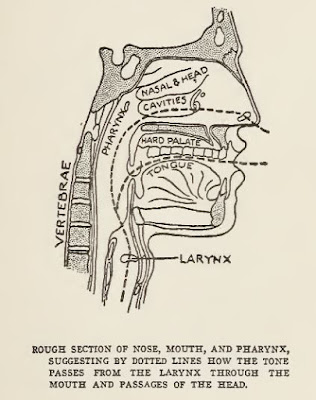In order to have the throat perfectly open it is necessary to have the jaw absolutely relaxed. (...)
The jaw is attached to the skull right beneath the temples in front of the ears. By placing your two fingers there and dropping the jaw you will find that a space between the skull and jaw grows as the jaw drops.
In singing this space must be as wide as is possible, for that indicates that the jaw is dropped down, giving its aid to the opening at the back of the throat. It will help the beginner sometimes to do simple relaxing exercises, feeling the jaw drop with the fingers. It must drop down, and it is not necessary to open the mouth wide, because the jaw is relaxed to its utmost.
However, for a beginner it is as well to practice opening the mouth wide, being sure to lower the jaw at the back. Do this many times a day without emitting any sound merely to get the feeling of what an open throat is really like. You will presently begin to yawn after you have done the exercise a couple of times. In yawning or in starting to drink a sip of water the throat is widely open, and the sensation is a correct one which the singer must study to reproduce. (...)
The singer should feel as if her jaw were detached and falling away from her face. As one great singer expresses it: "You should have the jaw of an imbecile when emitting a tone. In fact, you shouldn't know that you have one." Let us take the following passage from "The Marriage of Figaro", by Mozart: [Illustration: "Voi che sa-pe-te"]
This would make an excellent exercise for the jaw. Sing only the vowels, dropping the jaw as each one is attacked--"o, eh, ah." The o, of course, is pronounced like the English o and the i in voi like e. The e in che is pronounced like the English a. Sapete is pronounced sahpata. You now have the vowels, o, ee, a, ah, a. Open the throat wide, drop the jaw and pronounce the tones on a note in the easiest part of your voice. »
« Un gran numero di cantanti soffre del difetto chiamato "ingolamento" dell'emissione—vale a dire che attaccano o cominciano la nota nella gola. Presto o tardi questo attacco rovinerà la più bella delle voci. Come ho detto in precedenza, l'attacco della nota deve venire dall' "appoggio", o sostegno del fiato. Ma per avere l'attacco puro e perfettamente in tono dovete avere aperta la gola del tutto, perché è inutile cercare di cantare se la gola non è sufficientemente aperta per far passare liberamente il suono. Suoni ingolati o suoni stretti sono suoni che cercano di costringersi attraverso una gola semi aperta, bloccata o per insufficiente apertura della laringe o per ostruzione del passaggio della gola, a causa della base della lingua tenuta forzatamente giù e indietro in modo troppo esagerato o probabilmente per un basso palato molle.
Per avere la gola perfettamente aperta è necessario avere la mandibola assolutamente rilassata. (...)
La mandibola è attaccata al cranio proprio sotto le tempie davanti alle orecchie. Collocandovi due dita e lasciando cadere la mandibola scoprirete che cresce uno spazio tra il cranio e la mandibola nel momento in cui casca la mandibola.
Nel cantare, questo spazio deve essere quanto più ampio possibile, perché ciò indica che la mandibola è scesa, dando il proprio contributo all'apertura della parte posteriore della gola. Aiuterà il principiante praticare, talvolta, semplici esercizi rilassanti, sentendo la mandibola cadere con le dita. Deve cascare, e non è necessario spalancare la bocca, dato che la mandibola viene rilassata al massimo. Comunque, per un principiante è bene esercitarsi aprendo con ampiezza la bocca, assicurandosi di abbassare nel retro la mandibola. Fatelo varie volte al giorno senza emettere alcun suono, puramente per avere la sensazione di quel che sia davvero una gola aperta. Inizierete quanto prima a sbadigliare dopo aver fatto l'esercizio un paio di volte. Sbadigliando o cominciando a bere un sorso d'acqua la gola è spalancata, e la sensazione è quella corretta che il cantante deve studiarsi di riprodurre. (...)
La cantante dovrebbe sentire come se la sua mandibola fosse distaccata e cadesse dalla faccia. Come un grande cantante l'esprime: "Dovreste avere la mandibola di un imbecille quando emette un suono. Di fatto, non dovreste sapere di averne una." Prendiamo il seguente passo da "Le nozze di Figaro", di Mozart: [Immagine: "Voi che sa-pe-te"]
Questo costituirebbe un eccellente esercizio per la mandibola. Cantate solo le vocali, facendo cadere la mandibola come ciascuna viene attaccata--"o, e, a". La o, naturalmente, è pronunciata come l'inglese "o" e la i in "voi" come l'inglese "e". La e in "che" è pronunciata come l'inglese "a". "Sapete" è pronunciato in inglese "sahpata". Ora avete le vocali, o, i, e, a, e. Spalancate la gola, fate cadere la mandibola ed emettete i suoni su una nota nella parte più comoda della vostra voce. »
(tratto da: "Caruso and Tetrazzini on the Art of Singing" - Metropolitan Company, Publishers, New York, 1909)












